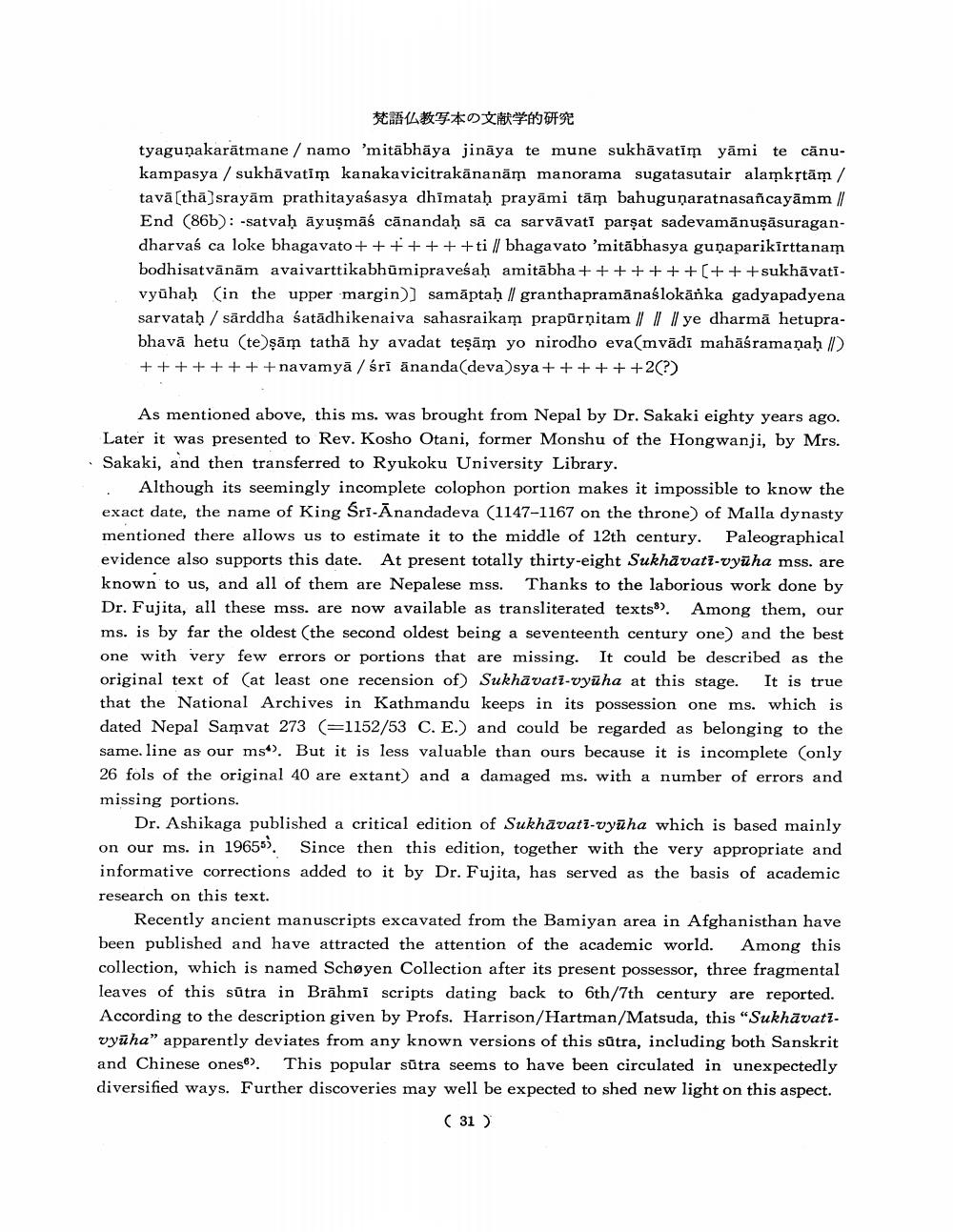________________
#4*50* 50 tyagunakarātmane / namo 'mitabhāya jināya te mune sukhāvatīm yāmi tecānukampasya / sukhāvatim kanakavicitrakānanām manorama sugatasutair alamkstām/ tavā(thā)srayām prathitayaśasya dhimataḥ prayāmi tām bahugunaratnasañcayāmm / End (86b): -satvaḥ āyuşmāś cānandaḥ sā ca sarvāvati parşat sadevamānuşāsuragandharvaś ca loke bhagavato+ + + + + + +ti // bhagavato 'mitābhasya gunaparikīrttanam bodhisatvänäm avaivarttikabhumipraveśah amitābha + + + + + + + (+ + +sukhāvati. vyūhaḥ (in the upper margin)] samāptaḥ Il granthapramānaślokāňka gadyapadyena sarvataḥ / sārddha satādhikenaiva sahasraikam prapūrņitam /|| || ye dharmā hetuprabhavā hetu (te)şām tathā hy avadat teşām yo nirodho eva(mvādi mahāśramanah (1) + + + + + + + + navamyā / śrī ānanda (deva sya + + + + + +2(?)
As mentioned above, this ms. was brought from Nepal by Dr. Sakaki eighty years ago. Later it was presented to Rev. Kosho Otani, former Monshu of the Hongwanji, by Mrs. · Sakaki, and then transferred to Ryukoku University Library.
Although its seemingly incomplete colophon portion makes it impossible to know the exact date, the name of King Sri-Anandadeva (1147-1167 on the throne) of Malla dynasty mentioned there allows us to estimate it to the middle of 12th century. Paleographical evidence also supports this date. At present totally thirty-eight Sukhāvati-vyūha mss. are known to us, and all of them are Nepalese mss. Thanks to the laborious work done by Dr. Fujita, all these mss. are now available as transliterated texts). Among them, our ms. is by far the oldest (the second oldest being a seventeenth century one) and the best one with very few errors or portions that are missing. It could be described as the original text of (at least one recension of) Sukhāvati-vyuha at this stage. It is true that the National Archives in Kathmandu keeps in its possession one ms. which is dated Nepal Samvat 273 (=1152/53 C. E.) and could be regarded as belonging to the same. line as our ms). But it is less valuable than ours because it is incomplete (only 26 fols of the original 40 are extant) and a damaged ms. with a number of errors and missing portions.
Dr. Ashikaga published a critical edition of Sukhāvati-vyūha which is based mainly on our ms. in 19655). Since then this edition, together with the very appropriate and informative corrections added to it by Dr. Fujita, has served as the basis of academic research on this text.
Recently ancient manuscripts excavated from the Bamiyan area in Afghanisthan have been published and have attracted the attention of the academic world. Among this collection, which is named Schøyen Collection after its present possessor, three fragmental leaves of this sūtra in Brāhmi scripts dating back to 6th/7th century are reported. According to the description given by Profs. Harrison/Hartman/Matsuda, this "Sukhāvativyūha" apparently deviates from any known versions of this sūtra, including both Sanskrit and Chinese onese). This popular sūtra seems to have been circulated in unexpectedly diversified ways. Further discoveries may well be expected to shed new light on this aspect.
( 31 )




